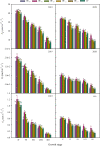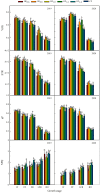Increase in cotton yield through improved leaf physiological functioning under the soil condition of reduced chemical fertilization compensated by the enhanced organic liquid fertilization
- PMID: 37719208
- PMCID: PMC10502217
- DOI: 10.3389/fpls.2023.1225939
Increase in cotton yield through improved leaf physiological functioning under the soil condition of reduced chemical fertilization compensated by the enhanced organic liquid fertilization
Abstract
Introduction: Low agricultural nutrient input efficiency remains a significant impediment for crop production globally. To address this issue in cotton agroecosystems, there is a need to develop sustainable crop nutrient management strategies to achieve high crop yields. We hypothesized that organic liquid fertilizer (OF) combined with reduced chemical fertilizer (CF) would enhance cotton yield by improving leaf functioning and soil properties. However, the underlying mechanism and its related process is poorly understood.
Methods: This study explored the effects of OF combined with reduced CF on cotton yield, physiology and soil properties. Treatments included a single application of CF (CF: N, P2O5 and K2O applied at 228, 131 and 95 kg ha-1) and combined applications of OF and CF (OF0.6-OF1.4) in the following ratios: OF0.6, OF+60% CF; OF0.8, OF+80% CF; OF1.0, OF+100% CF; OF1.2, OF+120% CF; OF1.4, OF+140% CF.
Results and discussion: The result showed that compared with CF, OF0.8, OF1.0 and OF1.2 increased soil organic matter (SOM) content by 9.9%, 16.3% and 23.7%, respectively. Compared with CF, the OF0.6, OF0.8, OF1.0, and OF1.2 treatments increased leaf area (LA) by 10.6-26.1%, chlorophyll content (Chl content) by 6.8-39.6%, and the efficiency of photosystem II (PSII) light energy (Y(II)), electron transfer rate of PSII (ETR) and photochemical quenching (qP) by 3.6-26.3%, 4.7-15.3% and 4.3-9.8%, respectively. The OF0.8 treatment increased net photosynthetic rate (P n), stomatal conductance (G s) and transpiration rate (E) by 22.0%, 27.4% and 26.8%, respectively, resulting in higher seed cotton yield. The seed cotton yield and economic coefficient were positively correlated with P n, E, G s and Y(II) from the full boll stage to the boll opening stage. In summary, the OF0.8 treatment can maintain a high SOM content and photosynthetic performance with reduced chemical fertilizer input without sacrificing yield. The integration of OF+80% CF (OF0.8) is a promising nutrient management strategy for highly efficient cotton production under mulch drip irrigation systems.
Keywords: economic coefficient; organic liquid fertilizer; photosynthetic performance; seed yield; sustainable agriculture.
Copyright © 2023 Shi, Hao, Khan, Li, Li, Shi, Tian, Nepal, Wang and Luo.
Conflict of interest statement
The authors declare that the research was conducted in the absence of any commercial or financial relationships that could be construed as a potential conflict of interest.
Figures













Similar articles
-
Organic Liquid Fertilizer Coupled With Single Application of Chemical Fertilization Improves Growth, Biomass, and Yield Components of Cotton Under Mulch Drip Irrigation.Front Plant Sci. 2022 Jan 20;12:763525. doi: 10.3389/fpls.2021.763525. eCollection 2021. Front Plant Sci. 2022. PMID: 35126408 Free PMC article.
-
[Effects of water and nitrogen management modes on the leaf photosynthetic characters and yield formation of cotton with under-mulch drip irrigation].Ying Yong Sheng Tai Xue Bao. 2013 Feb;24(2):407-15. Ying Yong Sheng Tai Xue Bao. 2013. PMID: 23705385 Chinese.
-
[Effects of reduced chemical fertilizer with organic fertilizer application on soil microbial biomass, enzyme activity and cotton yield].Ying Yong Sheng Tai Xue Bao. 2020 Jan;31(1):173-181. doi: 10.13287/j.1001-9332.202001.022. Ying Yong Sheng Tai Xue Bao. 2020. PMID: 31957394 Chinese.
-
Does the application of biogas slurry reduce soil N2O emissions and increase crop yield?-A systematic review.J Environ Manage. 2023 Sep 15;342:118339. doi: 10.1016/j.jenvman.2023.118339. Epub 2023 Jun 13. J Environ Manage. 2023. PMID: 37315456
-
Magnesium Fertilization Improves Crop Yield in Most Production Systems: A Meta-Analysis.Front Plant Sci. 2020 Jan 24;10:1727. doi: 10.3389/fpls.2019.01727. eCollection 2019. Front Plant Sci. 2020. PMID: 32038691 Free PMC article.
Cited by
-
Response of the soil hydrothermal environment and cotton yield to different irrigation quotas under biodegradable mulch film in oasis cotton fields: a three-year study.Front Plant Sci. 2025 Mar 21;16:1521635. doi: 10.3389/fpls.2025.1521635. eCollection 2025. Front Plant Sci. 2025. PMID: 40190651 Free PMC article.
References
-
- Agbede T. M., Oladitan T. O., Alagha S. A., Ojomo A. O., Ale M. O. (2010). Comparative evaluation of poultry manure and NPK fertilizer on soil physical and chemical properties, leaf nutrient concentrations, growth and yield of yam (Dioscorea rotundata Poir) in Southwestern Nigeria. World J. Agric. Sci. 6, 540–546. Available at: https://www.mendeley.com/catalogue/e2ef0061-2a30-30cf-b39d-083e332ceed6/.
-
- Ahangera M. A., Qi M., Huang Z., Xu X., Begum N., Qin C., et al. . (2021). Improving growth and photosynthetic performance of drought stressed tomato by application of nano–organic fertilizer involves up–regulation of nitrogen, antioxidant and osmolyte metabolism. Ecotoxicol. Environ. Saf. 216, 112195. doi: 10.1016/j.ecoenv.2021.112195 - DOI - PubMed
-
- Arshad A., Raza M. A., Zhang Y., Zhang L., Wang X., Ahmed M., et al. . (2021). Impact of climate warming on cotton growth and yields in China and Pakistan: a regional perspective. Agriculture 11, 97. doi: 10.3390/agriculture11020097 - DOI
-
- Chen H. N., Zhou H. P., Wen Y. L., Xiang Y., Cheng M. (2022). Ecological stoichiometric characteristics of soil nutrients and eco-enzymatic activities under different long-term fertilizations in a cinnamon soil. Plant Nutr. Fert. Sci. 28, 972–983. doi: 10.11674/zwyf.2021505 - DOI
-
- Dębska B., Długosz J., Piotrowska–Długosz A., Banach–Szott M. (2016). The impact of a bio–fertilizer on the soil organic matter status and carbon sequestration—results from a field–scale study. J. Soil Sediment. 16, 2335–2343. doi: 10.1007/s11368-016-1430-5 - DOI
LinkOut - more resources
Full Text Sources
Research Materials

